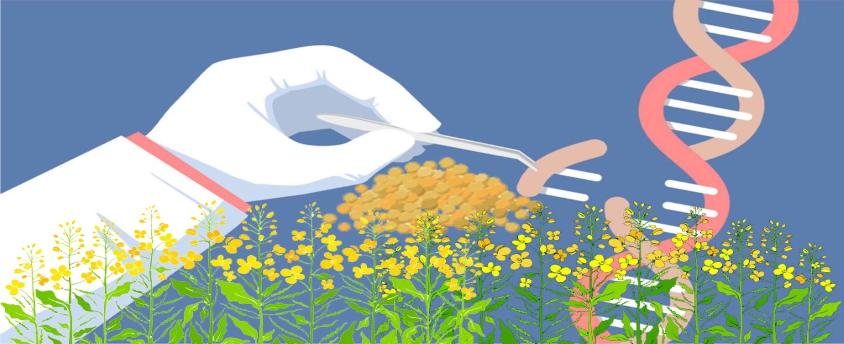Genetically modified Crops and Transgenic Technology Needs Precautions
24, Dec 2022

Prelims level : Economy
Mains level : GS-III Economy - Agriculture and related issues Indian Economy, Issues relating growth and development, employment
Why in News?
- The Supreme Court’s Technical Expert Committee and two unanimous reports of multi-party parliamentary standing committees have recommended that genetically modified (GM) Herbicide Tolerant (HT) crops should be banned in India.
Why transgenic technology is worrisome?
- Uncontrollable and irreversible: Transgenic technology, unlike other technologies, is uncontrollable and irreversible after environmental release.
- Self-propagation and proliferation: Living Modified Organisms (LMOs), as the Cartagena Protocol on Biosafety refers to Genetically Modified Organisms (GMOs), propagate themselves and proliferate.
- Long term assessment is necessary: This process cannot be reversed. Therefore, any deliberate environmental release has to be only after thorough, independent, peer-reviewed assessment of long-term implications.
- Precaution is necessary: The precautionary principle is a cornerstone because of the unpredictability and time lag of serious outcomes manifesting in highly complex living systems, and their irreversibility. To draw a parallel, not a single one of 330 invasive species (for example, lantana, parthenium) in India has yet been eliminated, despite estimated damage of Rs 8.3 trillion by just 10 of them!
Reality check on GM crops
- Less countries adopted GM technology: More than 25 years after their introduction, GM crops are still globally grown in just 29 out of 172 countries. Moreover, 91 per cent of GM crop area continues to be in just five countries (USA, Brazil, Argentina, Canada, India).
- BT cotton demand is declining: Most countries of Europe and Japan, Israel, Russia, Malaysia etc., do not grow GM crops. In China, a first adopter, Bt cotton area has been declining and non-GM hybrid technology is used for rapeseed/mustard.
- Heavy focus on two traits only: Only two traits are present in over 85 per cent of GM crops grown herbicide tolerance (HT, where crop plants are modified to withstand large amounts of toxic weed-killing chemicals), and/or insect resistance (pesticidal toxin, usually Bt, is produced inside the plant).
Negative impact of HT crops:
- Damage to ecology: HT crops result in not only ecological damage, but human health impacts for consumers. Like tobacco, once declared safe, the effects take long to manifest.
- Honey production will be affected: Beekeepers say that HT mustard will affect honey production and contaminated honey will damage exports.
- Human health will be affected: As regards human health, probable carcinogenicity, neuro-toxicity, reproductive health problems, organ damage etc. have been documented by independent research on GM crops and associated herbicides, once claimed by developers and regulators to be “safe”.
- Campaign against release of GM crops: Like thousands of doctors in other countries, over 100 eminent Indian doctors have conveyed their concerns asked that no HT food crops be released and the planted GM mustard be uprooted before flowering.
What is the issues vis-e vis DMH-11 Mustard crop?
- Proponent says Mustard is not a HT crop: It is claimed that DMH-11 is not an HT crop as the use of the Bar gene which confers an herbicide tolerance trait is essentially for the pollination control technology in creating hybrids, and glufosinate herbicide will only be used during seed production.
- Opponent says it’s a HT crop: The reality is that by virtue of the Bar gene being present in both parental lines, and thereby also in all their hybrid offspring, this GM mustard can withstand application of a toxic weedkiller, glufosinate, including in farmers’ fields. It should therefore have been assessed as an HT crop.
- Government failed to prevent illegal use of HT cotton: If governments, for over 10 years, have been aware of the illegal planting of herbicide tolerant cotton and rampant illegal use of glyphosate on such HT cotton, and have been unable or unwilling to stop this, what “regulatory process” will now prevent farmers in search of low-cost weeding options from spraying glufosinate on herbicide tolerant mustard?
What are the observations of SC and parliamentary Committee?
- Absence of regulatory protocol: The ongoing litigations in the Supreme Court are about serious shortcomings in our regulatory regime. Minutes of meetings of the regulatory body GEAC and the “guidelines and protocols” on the regulator’s website reflect an absence of regulatory protocols for HT crops.
- Inadequate bio testing: And yet a crop with an HT trait is being released in the environment! The technical expert committee (TEC) appointed by the SC and the unanimous multi-party reports of two parliamentary standing committees have exposed serious lapses and inadequacies in bio-safety testing.
- Against the release of GM crops: They all advised that herbicide tolerant crops, which GM Mustard is, should not be released in Indian conditions.
- Government panel recommended the ban: Even the government-nominated experts in the TEC asked for a ban on HT crops. The government, surely, cannot call them unscientific.
- No independent participant in testing: Testing on GM mustard has been done with test protocols evolved by the crop developer, and most tests were done by the applicant. No independent health expert participated in the committees that looked at GM mustard safety.
- No biosafety data: To this day, biosafety data of GM mustard has not been posted on the regulator’s website for independent scrutiny.
Conclusion:
- GM crop transgenic technology comes with mixed baggage. Government must strike the balance between biodiversity concern and welfare of farmers. Outright ban or permission without credible data and scrutiny must be avoided.






